#newnham college
Photo
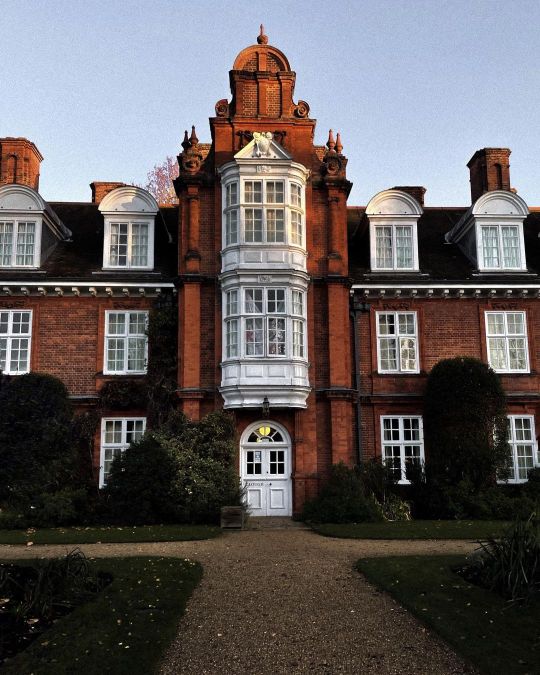




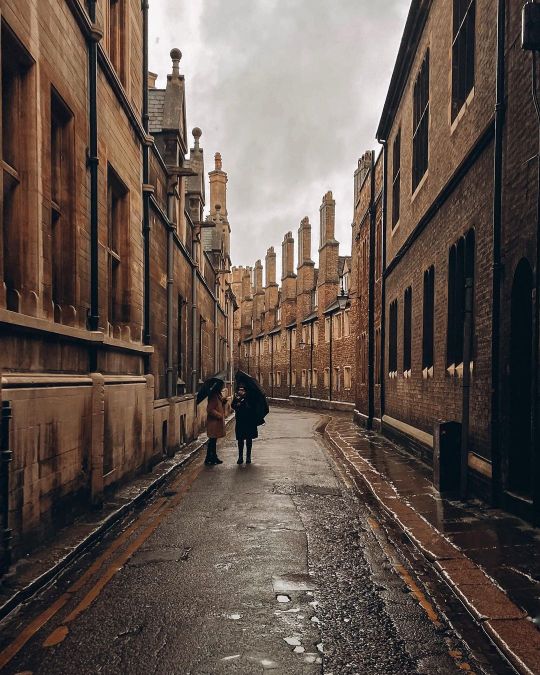
Instagram credit: fieldnotesbyfi
#bradford-on-avon#wiltshire#newnham college#selwyn college cambridge#cambridgeshire#cambridge#visit england#england#academia#dark academia#dark academia aesthetic#academic#streets#architecture
2K notes
·
View notes
Text
#national trust#mary beard#octavia hill lecture#colonial links#historic houses#social reformer#octavia hill#far-right#british politics#2020 report#colonial loot#slave trade#british empire#diversity#community engagement award#arts culture theatre awards#actas#royal society#london#postcolonial#wokery#british museum#classics#cambridge university#newnham college#royal academy of arts#hilary mcgrady#heritage#culture wars#historic collections
0 notes
Text
Dame Millicent Fawcett (1847-1929) is portrayed in this intimate painting by Ford Madox Brown (c.1872), dedicating her life to her blind, much older husband, Henry Fawcett. She was also a leading light of women's causes: uniting 17 suffrage societies to found the National Union of Women's Suffrage Societies, helping found Newnham College Cambridge for women and children endangered during the Boer War in South Africa. She lived long enough to see all women get the vote.

"Normal Women: 900 Years of Making History" - Philippa Gregory
#book quotes#normal women#philippa gregory#nonfiction#millicent fawcett#intimate#ford madox brown#blind#henry fawcett#united#national union of women's suffrage societies#newnham college#cambridge#abolition#slave trade#boer war#south africa#equality
1 note
·
View note
Text
The Tower of Beauty and Friendship, Ambleside, Cumbria
Eller How is a handsome villa, high above the town of Ambleside. In 1863 it was bought by the Boyle family, and soon after they added this curious prospect tower. Known as the Tower of Beauty and Friendship, thanks to a unique element of the design, it stands on a mound in the gardens.
Continue reading Untitled

View On WordPress
#Ambleside#Anne Jemima Clough#Armitt Museum#Charlotte Mason#Clara Asch#Eleanor Hocking#Eller How#Harriet Martineau#Henry Boyle#lake district#Newnham College#Tower of Beauty and Friendship#windermere
0 notes
Note
Which college were you in at cambridge and did you like it?
newnham! and yes i absolutely loved it, my college was one of the true bright spots of my experience there :')
#if i'd stayed on for a phd i would've swapped over to one of trinity/king's/peterhouse bc they offered me funding#but if i'd had the choice i would've stayed at newnham tbh#being in an all-women's college was such a salve considering how the rest of the university community treats women lol#anon#ask
2 notes
·
View notes
Text
OFMD Stede Bonnet as a Macaroni: Wealth, Gender and Sexuality in the 18th Century Fashion World
Historical Inaccuracy in Our Flag Means Death? Never!
Historical inaccuracy! I hear you cry. A Macaroni in 1717!?! It is true macaroni fashion was really a late-18th century fashion trend, seemingly reaching its peak in the 1770s. However Our Flag Means Death is nothing if not historically inaccurate. Stede’s costumes seem to take inspiration from across the 18th century rather than worrying about what would have actually been worn in 1717.
Early 18th century suits tended to have round necklines, loose-fitting sleeves with wide cuffs, long waistcoats that stoped just above the knee, and coats with full skirts just a little longer that the waistcoat.

[Left: Matthew Prior, oil on canvas, c. 1713-1714, by Alexis-Simon Belle, photo credit: St John's College, University of Cambridge, via Art UK.
Middle: Matthew Hutton of Newnham, Hertfordshire, oil on canvas, c. 1715, by Johannes Verelst, photo credit: National Trust Images, via Art UK.
Right: William Leathes, Ambassador Brussels, oil on canvas, c. 1710-1711, by Herman van der Myn, photo credit: Colchester and Ipswich Museums Service: Ipswich Borough Council Collection, via Art UK.]
As the century continued we get standing collars and turned down collars but round necklines were still around as well, sleeves got tighter with smaller cuffs, the waistcoats got shorter and the coats lost their skirts.
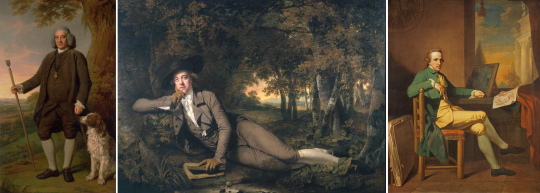
[Left: Thomas ‘Sense’ Browne, oil on canvas, c. 1775, by Nathaniel Dance-Holland, photo credit: Yale Center for British Art, via Art UK.
Middle: Sir Brooke Boothby, oil on canvas, c. 1781, by Joseph Wright of Derby, photo credit: Tate, via Art UK.
Right: David Allan, oil on canvas, c. 1770, by David Allan, photo credit: Royal Scottish Academy/National Galleries of Scotland (Antonia Reeve), via Art UK.]
Stede’s collars are inconstant some are rounded but others are turned down and Ed’s purple suit has a standing collar. Many of Stede’s coats have wide cuffs, but most have little skirt to them. His teal suit from the pilot has a bit of a skirt but its paired with a short waistcoat.

Most of Stede’s waistcoats are short with the exception of his suits from both the wedding portrait with Mary and the the family portrait. Both suits are very straight giving him a boxy appearance and are pretty different from most of the suits we see him in.

All in all I don’t think they were aiming for historically realistic clothes but with the collars, short waistcoats, and lack of skirts I get more of a late-18th century vibe.
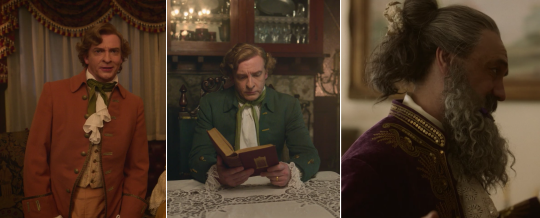
So what was a Macaroni?
A Classical Dictionary of the Vulgar Tongue (1785), defined macaroni as follows:
An Italian paste made of flour and eggs; also a fop, which name arose from a club, called the maccaroni club, instituted by some of the most; dressy travelled gentlemen about town, who led the fashions, whence a man foppishly dressed, was supposed a member of that club, and by contraction stiled a maccaroni.
The macaroni club was said to have comprised of young men who had gained a taste for French and Italian textiles on their Grand Tour (a traditional trip taken tough Europe by upper class men when they came of age). The earliest reference to the club is from a letter from Horace Walpole to Lord Hertford on the 6th Feb 1764:
at the Maccaroni Club (which is composed of all the travelled young men who wear long curls and spying-glasses),
In his book Pretty Gentleman: Macaroni Men and the Eighteenth-Century Fashion World Peter McNeil suggest the club was actually Almack’s. Almack’s was a private club at 50 Pall Mall that was attended by prominent Whigs including Sheridan, Fox and the Price of Wales. (p52) While the name may have originated from the men at Almack’s it was soon used to describe any man who followed the associated fashion trends.
So what were these trends?
Hair
“Still lower let us fall for once, and pop
Our heads into a modern Barber’s shop;
What the result? or what we behold there?
A set of Macaronies weaving hair.”
~ The Macaroni by Robert Hitchcock
Probably the most iconic aspect of macaroni fashion was the hair. “It was the macaroni attention to wigs that caused most consternation” explains Peter McNeil. The macaroni hair “matched the towering heights of the female coiffure, with a tall toupee cresting at the centre front. The wig generally had a long tail at the neck (’queue’), which when folded double was called the ‘cadogan’, all of which required regular dressing with pomade and powder, sometimes in the colours of pink, green or red.” (p45)
The height of the macaroni hair was a point of particular fascination in macaroni caricature exaggerating it beyond what the macaroni were probably actually wearing. Compare below Tom’s hair in the satirical print What is this my son Tom to the self portrait of Richard Cosway, who was satirised by Mary Darly as “The Miniature Macaroni” (a reference both to his height and his career as a miniature painter).
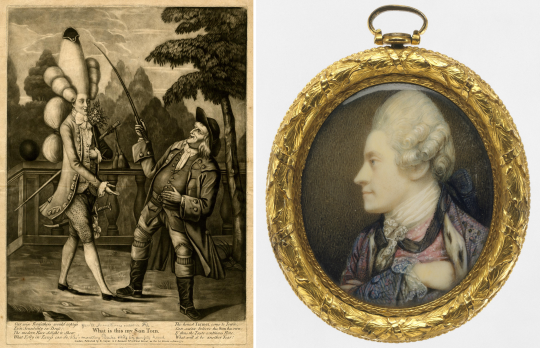
[Left: What is this my son Tom, print, c. 1774, published by Sayer & Bennett, via The British Museum.
Right: Self-Portrait, Ivory, c. 1770–75, by Richard Cosway, via The Met.]
The way Stede usually wears is hair is not particularly macaroni nor particularly 18th century for that matter. The exception to this is his wig from The Best Revenge Is Dressing Well though even this doesn’t have the iconic macaroni hight.

Interestingly both Stede and Ed are wearing flowers in their hair. While there are certainly depictions of women with flowers in there hair I’m not aware of this being a trend in mens fashion at all. However macaroni were known for wearing large nosegays.
While the tall hair was certainly iconic not all macaroni wore their hair tall. Joseph Banks, who was satirised as “The Fly Catching Macaroni” by Matthew Darly, is depicted in his portrait with a fairly typical 18th century hairstyle. Its not the hair alone that makes a macaroni, it was just one aspect of the fashion.
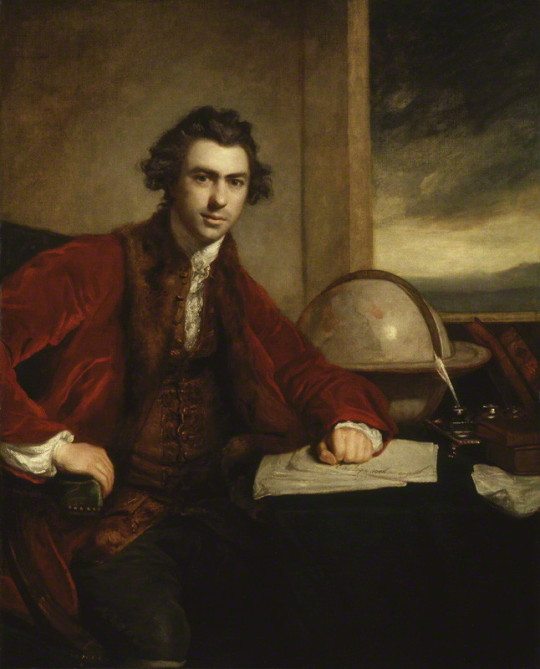
[Sir Joseph Banks, oil on canvas, c. 1771-1773, by Sir Joshua Reynolds, via Wikimedia.]
Suit
“If I went to Almack’s and decked out my wrinkles in pink and green like Lord Harrington, I might still be in vogue.” ~ Horace Walpole to Lord Hertford, 25 Nov 1764
Menswear of the period consisted of the same basic elements; shirt, stockings, breeches, waistcoat and coat. What differentiated the macaroni from others was the fabric, cut, colour and trimmings of the suit. “At a time when English dress generally consisted of more sober cuts and the use of monochrome broadcloth,” explains Peter McNeil “macaronism emphasised the effects associated with French, Spanish and Italian textiles and trimmings”. Popular amongst macaroni were brocaded and embroidered silks and velvets, sometimes further embellished with metallic sequins, simulated gemstones and raised metallic threads. Popular colours included pastels, pea-green, pink, red and deep orange. (McNeil, p30-32)
Far from wearing “monochrome broadcloth” Stede likes a “fine fabric” and dresses in a range of colours, we see him in teal, pink, purple, green, white, red, peach &c.
Tightly cut French style suits known as habit à la française were popular with macaroni. (McNeil, p14) Stede’s suits vary somewhat in cut but some are very French. The peach suit Stede wears in We Gull Way Back particularly has a very macaroni feel to me. Compare it to the English suit (left) and the French suit (right).

From the back you can see the English suit has more of a skirt to it.

Both Stede’s suit and the French suit are somewhat plain but have been paired with a floral embroidered waistcoat, while the English suit has a matching plain black waistcoat.
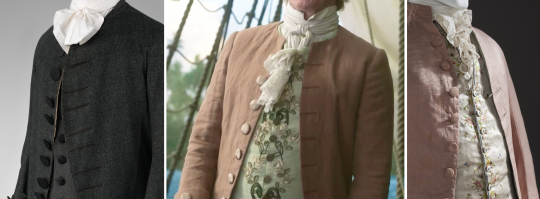
[Left: English suit, wool, silk, c. 1755–65, via The Met, number: 2009.300.916a, b.
Right: French suit, Silk plain weave (faille), c. 1785, via LACMA, number: M.2007.211.47a-b.]
Fabric covered button’s were common in the 18th century, you can see them on both the French and English coats above. In contrast Stede wears a lot of metal buttons. Steel buttons were popular amongst macaroni, a trend that was satirised in Steel Buttons/Coup de Bouton.

[Steel Buttons/Coup de Bouton, print, c. 1777, by William Humphrey, via The British Museum.]
Pumps and Parasols
“Maccaronies who trip in pumps and with Parasols over their heads” ~ Mrs Montagu
High heels had been popular amongst men during the 17th century. The Royal Collection Trust explains:
In the first half of the 17th century, high heeled shoes for men took the form of heeled riding or Cavalier boots as worn by Charles I. As the wearing of heels filtered into the lower ranks of society, the aristocracy responded by dramatically increasing the height of their shoes. High heels were impractical for undertaking manual labour or walking long distances, and therefore announced the privileged status of the wearer.
(Royal Collection Trust, High Heels Fit for a King)
In 17th century France Louis XIV popularised red-heels by turning them into a symbol of political privilege, which in turn spread the fashion to England. But with the sobering of menswear in England around the turn of the century the high heel and the red-heels went out of fashion. (see Bata Shoe Museum Toronto, Standing TALL: The Curious History of Men in Heels)
The high heel had a bit of a resurgence in the 1770s with macaroni fashion. The Natural History of a Macaroni snipes that the macaroni’s “natural hight is somewhat inferior to he ordinary size of men, through by the artificial hight of their heels, they in general reach that standard”. (Walker’s Hibernian Magazine, July 1777, p458)
Red-heels were reintroduced to England by young men returning from their Grand Tours. A young Charles James Fox (satirised by Mathew Darly as “the Original Macaroni”) wore such French style red-heeled shoes. The Monthly Magazine recalls a young Fox as a “celebrated “beau garçon” with “his chapeau bras, his red-heeled shoes, and his blue hair-powder.” (Oct 1806) and The Life of the Right Honorable, Charles James Fox recalls him in his “suit of Paris-cut velvet, most fancifully embroidered, and bedecked with a large bouquet; a head-dress cemented into every variety of shape; a little silk hat, curiously ornamented; and a pair of French shoes, with red-heels;” (p18) And in Recollections of the Life of the Late Right Honorable Charles James Fox B.C. Walpole recalls him as “one of the greatest beaus in England,” who “indulged in all the fashionable elegance of attire, and vied, in point of red heels and Paris-cut velvet with the most dashing young men of the age. Indeed there are many still living who recollect Beau Fox strutting up and down St. Jame’s-street, in a suit of French embroidery, a little silk hat, red-heeled shoes, and a bouquet nearly large enough for a may-pole.” (p24)
Compare the French style red-heeled shoes of Louis XIV to Stede’s red-heeled shoes.

[Left: detail of Louis XIV, oil on canvas, c. 1701, by Hyacinthe Rigaud, via Wikimedia.]
However most macaroni were depicted wearing the more standard late 18th century low-heeled bucked shoes. Where they distinguished themselves was the size and decoration of the buckles. “Such buckles could be set with pate (lead glass) or ‘Bristol stones’ (chips of quartz), or diamonds if you were very rich.” Explains peter McNeil, “The new macaroni fashion was for huge silver or plated Artois shoe buckles which the Mourning Post claimed weighed three to eleven ounces.” (p90)
While certainly not as iconic has his heels Stede also wears these sorts of shoes. Compare below the shoes from a macaroni caricature to Ed wearing Stede’s shoes (I couldn’t get a good shot of Stede wearing them).

[Left: detail of How d'ye like me, print, c. 1772, published by: Carington Bowles, via The British Museum.]
“A great many jewelled accessories accompanied the macaroni look”, writes Peter McNeil, “They included hanger swords, very long canes, clubs, spying glasses and snuff-boxes.” (p68) Tragically we don’t see Stede with a fashionable dress sword or a cane but we do see him with another accessory popular amongst macaroni; a parasol.
Popular in France parasols/umbrellas were adopted by the macaroni. They were popular amongst both men and woman in France but in England they had a feminine connotation. (McNeil, p129) In the 1780s as umbrellas became more popular amongst men there was a cultural pushback to the perceived gender transgression. On the 16th of August 1780 the Morning Post complains of of the “canopy of umbrellas” bemoaning that “the effeminacy of the men, inclines them to adopt this necessary appendage of female convenience”. On the the 4th Oct, 1784, the Morning Chronicle published a letter complaining of “that vile foppish practice of sheltering under a umbrella”. The author of this tirade writes that while “the ladies should be allowed to secure their beauty and persons from the heat of the sun, or the inclemency of the weather,” because “it is natural, and has a striking effect”, that “to see a great lubberly cit, bounce from his shop, with a coat, hat, and wig that are not together worth one groat,” sheltering “from the influence of the solar beam” was “intolerable.” However:
The macaroni being of the doubtful gender, may in part claim a feminine right; his dress is too delicate to bear an heavy shower, perhaps his person is so too; but a coach, if a clean one is to be found would serve his purpose much better, as there would be less likelihood of his being washed away into the kennel, which he deserves to be kicked into for his d-----d affectation.

Wealth
Born from rich young men returning from their tours with a taste for French and Italian textiles macaroni fashion was expensive. Certainly a working class man would not be able to afford Stede’s wardrobe. Both the sheer amount of clothes he has as well has the fabrics those clothes are made of are indications of wealth. However to say that Stede’s wardrobe is only an indication of wealth would be missing part of picture.
Most rich upper class English men (including colonial) wore plain monochrome suits. Even amongst the gentry macaroni fashion was not the norm. Compare bellow George Washington (left) who was a wealthy planation owner, but notably not a macaroni, to Richard Cosway (right) who was a famous macaroni.

[Left: George Washington, oil on canvas, c. 1796, by Gilbert Stuart, via Pennsylvania Academy of the Fine Arts.
Right: Detail of The Academicians of the Royal Academy, oil on canvas, c. 1771-72, by Johan Zoffany, via The Royal Collection Trust.]
In spite of the expense macaroni fashion was not exclusive to the upper classes. “Macaroni dress was not restricted to members of the aristocracy and gentry,” writes McNeil, “but included men of the artisan, artist, and upper servant classes, who wore versions of this visually lavish clothing with a distinctive cut and shorter jackets. Wealthier shopkeepers and entrepreneurs also sometimes wore such lavish clothing, particularly those associated with the luxury trades, such as mercers and upholsterers -” (p14)
It was possible to copy certain aspects of macaroni fashion on a cheeper budget. The hairstyle in particular was achievable without braking the bank. And there were ways to replicate the effects of certain expensive fashion trends for cheeper prices. For example patterns could be printed rather than embroidered.

[Left: printed waistcoat, cotton, c. 1770–90, via The Met, number: 35.142.
Right: embroidered waistcoat, silk, c. 1780–89, via The Met, number: 2009.300.2908.]
The Town and Country Magazine complains “we now have Macaronies of every denomination, from the colonel of the Train’s-Bands down to the errand-boy.” (McNeil, p169) The Morining Post mocks macaronies that couldn't financially keep up with the trends:
The macaronies of a certain class are under peculiar circumstances of distress, occasioned by the fashion, now so prevalent, of wearing enormous shoe-buckles; and we are well assured that the manufactory of plated ware was never known to be in so flourishing a situation.
(14 Jan, 1777)
In 18th century England, class was about more than just how much money you had. It was about pedigree. “English society was particularly alert to those whom it felt were using clothes to achieve a social status they did not merit” explains McNeil. Richard Cosway was a famous macaroni from modest background. Born to a Devonshire headmaster he was sent to London to study painting at 12. He became a very successful miniature painter and grew rich from the patronage of the Prince of Wales (later George IV) and Whig circles. In Nollekens and his Times J.T. Smith writes of Cosway:
He rose from one of the dirtiest boys, to one of the smartest of men. Indeed so ridiculously foppish did he become that Mat Darly, the famous caricature print-seller, introduced an etching of him in his window in the Strand, as ‘The Macaroni Miniature Painter’
(McNeil, p105-14)
But it was not only the Darlys that satirised Cosway Hannah Humphrey mocks Cosway as a social climber in A Smuggling Machine or a Convenient Cos(au)way for a Man in Miniature which depicts him standing under the petticoats of his much taller wife Maria. In the background there is a picture of Cosway climbing a ladder that rests upon a woman (she is believed to either be Angelica Kauffman or the Duchess of Devonshire). Below this reads:
Lowliness is Young Ambitions Ladder,
Whereto the climber upward turns his Face
But when he once attains the upmost round
He then unto the Ladder turns his back,
Looks unto the clouds - scornin [sic] the base degrees
By which he did assend.
Shak. Jul. Caesar.

[A Smuggling Machine or a Convenient Cos(au)way for a Man in Miniature, print, c. 1782, by Hannah Humphrey, via The British Museum.]
Another famous macaroni not born into the aristocracy was Julius Soubise. Brought to England from the West Indies as a slave he was taken in by Catherine Hyde, the Duchess of Queensbury. She gave him a leisured childhood, in which he was taught to play and compose for the violin, was taught to fence by Domenico Angelo, and learned oration from David Garrick. “Macaroni caricatures of Soubise parodied a foppish upstart whose outfits and entertainments, financed by the Duchess, affronted both racial and social expectations of an African male.” Writes Petter McNeil, Soubise was satirised as “a Mungo Macaroni” an “offensive term meaning a rude or forward black man.” (p118)
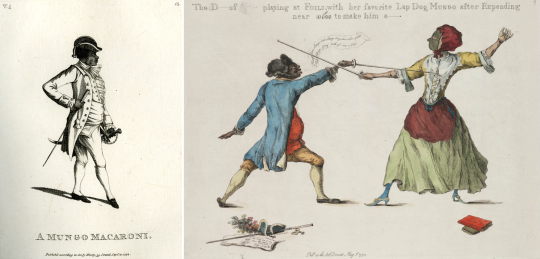
[Left: A Mungo Macaroni, print, c. 1772, by Matthew Darly, via The British Museum.
Right: The D------ of [...]-- playing at foils with her favorite lap dog Mungo after expending near £10000 to make him a----------*, print, c. 1773, by William Austin, via Yale Center for British Art.]
The expense of Stede’s wardrobe is a key part of the narrative. Stede has nice fancy luxurious things. Ed wants nice fancy luxurious things. Ed was born a poor brown boy and while he may be rich now he can never truly change his class. He could be as rich as Richard Cosway or Julius Soubise but to the gentry he will always be that poor brown boy.

Gender
As we have already seen in the tirade against men using umbrellas the macaroni was perceived as being of “the doubtful gender”. (The Morning Chronicle, 4 Oct, 1784)
The Natural History of a Macaroni writes that there “has within these few years past arrived from France and Italy a very strange animal, of the doubtful gender, in shape somewhat between a man and monkey,” that dresses “neither in the habit of a man or woman, but peculiar to itself”. The author states that “they are in no respect useful in this country”:
that the minister of the war department would give orders to have them enlisted for the service of America: we do not mean to put them on actual duty there. Alas! they are as harmless in the field, as they are in the chamber, but they may stand as faggots to cover the loss of real men.
(Walker’s Hibernian Magazine, July 1777, p458-9)
A “faggot” being “A man who is temporarily hired as a dummy soldier to make up the required number at a muster of troops, or on the roll of a company or regiment.” (see OED)

[The Masculine Gender & The Feminine Gender, etching with touches of watercolour, c. 1787, Attributed to Henry Kingsbury, via The Met.]
The macaroni wasn’t just considered effeminate because of the way they dressed but also because of their interests and the way walked and talked. Famous for playing fops and macaroni, the actor David Garrick did a lot to establish the character of the macaroni in the public mind. In his poem The Fribbleriad Garrick mocks the men who were offended by his performances asserting, perhaps accurately, that they were offended because it was them he mocked. He portrays a group of angry effeminate men meeting in order to seek revenge on him for his portrayal of them:
May we no more such misery know!
Since Garrick made OUR SEX a shew;
And gave us up to such rude laughter,
That few, ’twas said, could hold their water:
For He, that player, so mock’d our motions,
Our dress, amusements, fancies, notions,
So lisp’d our words, and minc’d our steps,
The macaroni had become more than simply an effeminate man, he had become a new sex. Something not quite man or woman. Something in-between. A new description of a macaroni asks the question:
Is it a man? ‘Tis hard to say - A woman then
- A moment pray -
So doubtful is the thing, that no man
Can say if ‘tis a man or woman:
Unknown as yet by sex or feature,
It moves - a mere amphibious creature.
(McNeil p169)
Sexuality
Much like today in the 18th century effeminacy was associated with homosexuality. Men who had sex with other men were known as mollies. A Classical Dictionary of the Vulgar Tongue (1785), defined a molly as “A Miss Molly; an effeminate fellow, a sodomite”. In the History of the London Clubs (1709), Ned Ward characterises mollies as follows:
There are a particular Gang of Wretches in Town, who call themselves Mollies, & are so far degenerated from all Masculine Deportment or Manly exercises that they rather fancy themselves Women, imitating all the little Vanities that Custom has reconcil’d to the Female sex, affecting to speak, walk, tattle, curtsy, cry, scold, & mimick all manner of Effeminacy.
“By the 1760′s,” explains Peter McNeil, “too much attention to fashion on the part of a man was read as evidence if a lack of interest in women”. (p152)
Macaroni were often portrayed as incapable or simply uninterested in sexual relations with women. This attitude is expressed by Mr. Bate in the following dialogue from The Vauxhall Affray; Or, the Macaronies Defeated:
Mr. Fitz-Gerall: I always though a fine woman was only made to be looked at.
Mr. Bate: Just sentiments of a macaroni. You judge of the fair sex as you do your own doubtful gender, which aims only to be looked at and admired.
Mr. Fitz-Gerall: I have as great a love for a fine woman as any man.
Mr. Bate: Psha! Lepus tute es et pulpamentum quæris?
Mr. Fitz-Gerall: What do you say, Parson?
Mr. Bate: I cry you mercy, Sir, I am talking Heathen Greek to you; in plain English I say, A macaroni you, and love a woman?
Mr. Fitz-Gerall: I love the ladies, for the ladies love me.
Mr Bate: Yes, as their panteen, their play-thing, their harmless bauble, to treat as you do them, merely to look at
While lack on interest in woman does not necessarily mean attraction to men, Matthew Darly takes the implication there in his 1771 set of macaroni caricatures which induces a print entitled Ganymede, a reference to Zeus’ male lover of the same name. Ganymede is believed to be a parody of Samuel Drybutter who had been arrested for attempted sodomy in January 1770. Darly also includes the character Ganymede in Ganymede & Jack-Catch. Jack-Catch is a reference to the infamous English executioner John Ketch. In the print Jack-Catch says, “Dammee Sammy you’r a sweat pretty creature & I long to have you at the end of my String.” Ganymede replies, “You don’t love me Jacky”. Jack-Catch is holding a noose with one hand and stroking Ganymede’s chin with the other. Jack-Catch is soberly dressed in typical 18th century menswear, while Ganymede’s dress is distinguished by his lace ruffles and styled wig. The print is not only suggesting that macaroni are sodomites but making a joke of the execution of them. The punishment for a sodomy at this time in England being death by hanging.

[Left: Ganymede, print, c. 1771, Matthew Darly, via The Met.
Right: Ganymede & Jack Catch, print, c. 1771, Matthew Darly, via The British Museum]
An anonymous letter to the Public Ledger (5 Aug, 1772) says blatantly what others had already implied. “The country is over-run with Catamites, with monsters of Captain Jones’s taste, or, to speak in a language witch all may understand, with MACCARONIES”. The writer warns macaroni who have “escaped detection” as sodomites and “therefore cannot fairly be charged” that they have not avoided suspicion:
Suspicion is got abroad-the carriage-the deportment-the dress-the effeminate squeak of the voice-the familiar loll upon each others shoulders-the gripe of the hand-the grinning in each others faces, to shew the whiteness of the teeth-in short, the manner altogether, and the figure so different from that of Manhood, these things conspire to create suspicion; Suspicion gives birth to watchful observation; and, from a strict observance of the Maccaroni Tribe, we very naturally conclude that to them we are indebted for the frequency of a crime which Modesty forbids me to name. Take warning, therefore, ye smirking group of Tiddy-dols: However secret you may be in your amours, yet in the end you cannot escape detection;
Bows on His Shoes
18th century shoes were typically buckled, laces and ribbons were simply unfashionable. As mentioned previously macaroni were distinguished by the size and decoration of the buckles. So are Stede’s bows simply ahistorical? Well there are references to 18th century men wearing laces and ribbons.
Towards the end of the 18th century laces started to come into fashion. Appeal from the Buckle Trade of London and Westminster, to the Royal Conductors of Fashion (1792) complained that despite how “tender and effeminate the appearance of Shoe Strings” the “custom of wearing them has prevailed.”
Perhaps the most intriguing reference is that of Commissioner Pierre Louis Foucault’s papers where he details the surveillance, investigation and entrapment of "pederasts” in Paris. It is important to note that the word “pederasty” was used synonymously with “sodomy” in the 18th century and did not denote age simply sex. An Universal Etymological English Dictionary (1726) defines “A pederast” as “a Buggerer” and “Pederasty” as “Buggery”.
Foucault and the men working with him identified particular clothing worn by men seeking sex with other men that he called the “pederastical uniform”. In Foucault’s papers men are described as being “attired in such a way as to be recognized by everyone as a pederast”, “clothed with all the distinctive marks of pederasty”, or simply “dressed like a pederast”. This “uniform” generally included “some combination of frock coat, large tie, round hat, small chignon, and bows on the shoes.” Jeffrey Merrick in his article on Foucault speculates that these men dressed this way to signal to each other. However when questioned by police they would understandably deny such a purpose, one man when questioned about his outfit responded that everyone “dresses as he sees fit”. (Jeffrey Merrick, Commissioner Foucault, Inspector Noël, and the “Pederasts” of Paris,1780-3)
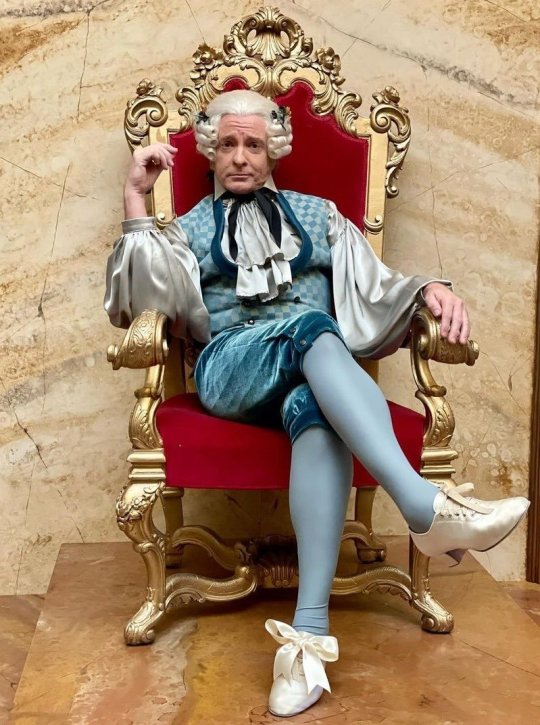
Conclusion
I’m not saying Stede is intended to be a macaroni. If that were the case they would have given him the iconic macaroni hairstyle. However the costuming team has clearly pulled from fashion trends that were associated with effeminacy and homosexuality. While OFMD is evidently wholly unconcerned with creating period accurate costumes the costumes are still clearly inspired by historical fashions. Perhaps the curtains really are just blue but maybe Stede wears bows on his shoes because he’s gay.
#I had way too much fun doing this#our flag means death#ofmd meta#stede bonnet#queer history#macaroni#historical fiction#fashion history
195 notes
·
View notes
Photo
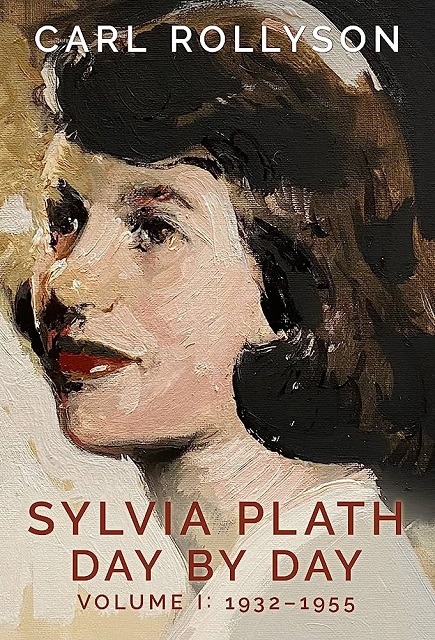
!NEW RELEASE!
Title: Sylvia Plath Day by Day, Volume 1: 1932-1955
Author: Carl Rollyson
Publication date: 15 August 2023
Pages: 400
Publisher: University Press of Mississippi (UPM)
Image source (cover & description): https://www.upress.state.ms.us
About the book:
“A fascinating investigation into the life and art of one of America’s greatest poets
Since Sylvia Plath’s death in 1963, she has become the subject of a constant stream of books, biographies, and articles. She has been hailed as a groundbreaking poet for her starkly beautiful poems in Ariel and as a brilliant forerunner of the feminist coming-of-age novel in her semiautobiographical The Bell Jar. Each new biography has offered insight and sources with which to measure Plath’s life and influence. Sylvia Plath Day by Day, a two-volume series, offers a distillation of this data without the inherent bias of a narrative.
Volume 1 commences with Plath’s birth in Boston in 1932, records her response to her elementary and high school years, her entry into Smith College, and her breakdown and suicide attempt, and ends on February 14, 1955, the day she wrote to Ruth Cohen, principal of Newnham College, Cambridge, to accept admission as an “affiliated student at Newnham College to read for the English Tripos.”
Sylvia Plath Day by Day is for readers of all kinds with a wide variety of interests in the woman and her work. The entries are suitable for dipping into and can be read in a minute or an hour. Ranging over several sources, including Plath’s diaries, journals, letters, stories, and other prose and poetry—including new material and archived material rarely seen by readers—a fresh kaleidoscopic view of the writer emerges.
Reviews
"The details in Rollyson’s Sylvia Plath Day by Day, Volume 1: 1932–1955 are a dream come true for the reader, fan, and scholar of Sylvia Plath. The seeds of so much of her creative writing are present, but Rollyson deftly does not foreshadow how events impact Plath’s life and when she transforms experiences from life to art. He lets each moment stand on its own importance."
"Sylvia Plath Day by Day, Volume 1: 1932–1955 is a must-have book for any reader interested in Plath. Detailed yet highly readable, it paints a portrait of a young woman who would become, as will be chronicled in volume 2, one of the seminal authors in the twentieth century."
"Sylvia Plath Day by Day, Volume 1: 1932–1955 fills the lacunae of existing biographies and uncovers new insights into its subject, as when Plath writes about her experiences at Smith, hearing ‘nasty little tag ends of conversation directed at you and around you, meant for you, to strangle you on the invisible noose of insinuation.’ Or her months in New York at Mademoiselle, which grow less mysterious here. Again, Carl Rollyson has provided us with an indispensable book on Sylvia Plath." “
You can order the book through their website or from other online shops.
#sylvia plath#new release#carl rollyson#sylvia plath day by day#sylviaplath#sylvia plath scholarship#university press of mississippi
28 notes
·
View notes
Text
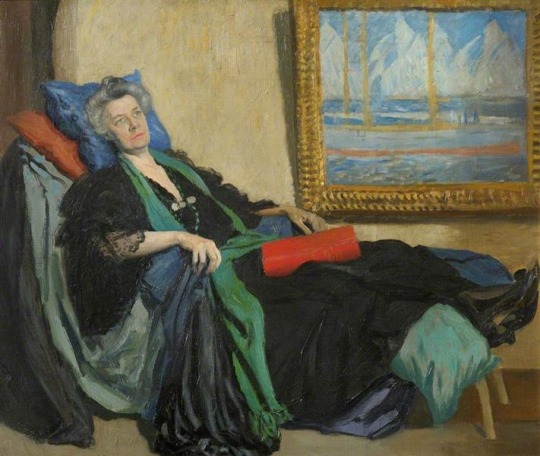

Augustus John
Jane Ellen Harrison, Newnham College
Philip Wilson Steer, A Procession of Yachts, 1892–3 (Pictured in Jane Ellen Harrison portrait by Augustus John.)
#augustus john#british artist#british painter#british painting#british art#welsh painter#welsh artist#portrait#portrait painting#portrait art#art on tumblr#modern art#art history#tumblr art#aesthetic#beauty#philip wilson steer#sailboats#sailing#seascape#boating
8 notes
·
View notes
Text

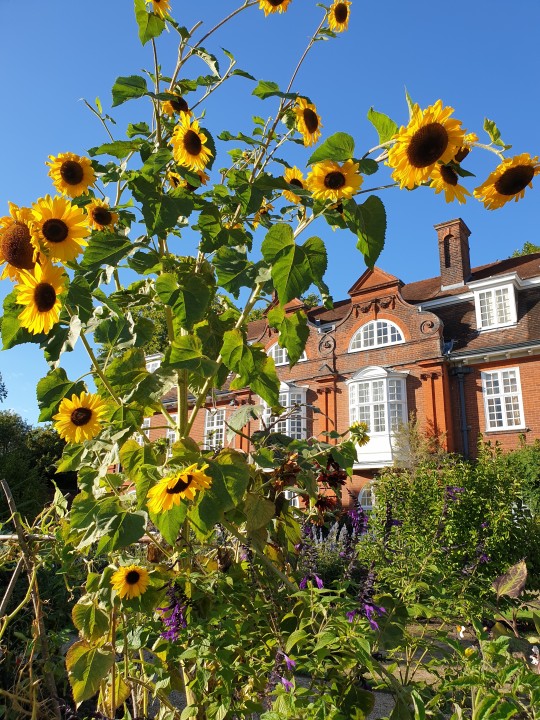




Autumn at Newnham College, Cambridge - September 22
22 notes
·
View notes
Text
Five Interesting English nonfiction books
A room of one's own by Virginia Woolf
First published in 1929, the essay was based on a series of lectures she delivered at Newnham College and Girton College, two women's colleges at Cambridge University in October 1928. While this extended essay in fact employs a fictional narrator and narrative to explore women both as writers of and characters in fiction, the manuscript for the delivery of the series of lectures, titled "Women and Fiction", and hence the essay, are considered non-fiction. The essay is generally seen as a feminist text, and is noted in its argument for both a literal and figural space for women writers within a literary tradition dominated by patriarchy.
2 notes
·
View notes
Text
20/5/2023
it's 3:50 in the damn morning and I have work at 1130AM... WTF!
I got fucking admitted to YorkU 48 damn hours ago.
I already accepted my offer at seneca- to that, I've been thinking about my next few years there
I already paid the down payment of $500
I spent over $300 on res that mom doesn't know about because I was so damn curious on Newnham rather than King City..then I got fucking revoked bc that was retarded asf even tho they still had 35 spots available... so why big rush me on that stupid questionnaire.
THEREFORE $800 and paying for courses havent even started yet
anddddddd I just submitted my thing to OSAP so fuck me
so yea, I am annoyed how they were fucking taking their time & playing w my feelings admitting me pretty fucking late in the game... which leads me to here trying to think straight.
I already played the hypothetical card w mom this morning if I were to change my mind to another school. and I know it will hurt her but as a front she says "everyone changes their mind" --> which btw made me internally cry bc I love her so much (increases the pressure even more to not fuck up any. decision for the following days whether I should stay in Seneca than pass my shot at York)
it was already so damn chaotic for dad to accept the fact im going to college. damn. how tf do I tell him, yeah I wasted ur money AGAIN for admission because IM CHNAGING MY MIND AGAIN but don't worry because this time it's at York...
I hate this thinking game
Cassie made a point how it is still possible to transfer no matter what
Alex too did make a point that having a balance life will be important
Judy was right this was my first choice if I were to get accepted
IM SO CONFUSED
I feel that because the last week I've been using my iPad as a check list to getting shit done like
calling PEI for a job
being transfers at PEI's Garage
pulling up at Montreal
calling Seneca for scholarships
calling Seneca for login difficulties
calling for residence info
that when and IF I were to think about York I would have to be doing all this shit in 2x speed meaningggggg
I have to inform RND and OVS to transfer my transcript to the admission office at York
get my York email working
[re]apply for residence at York
meaning my newer set of questions would be
[re]inquiring for York scholarships &&&& course enrolment
[re]applying / correcting my Osap application
alsoooo meaning that paying residence is another affaire (such as in Seneca offered 3 different options on how to pay the instalment for residence)
--- currently 4:39 AM ----
I have been on so many Reddits reviews because I am just being pulled from one side to the other when trying to decide what school VS the other.
3 notes
·
View notes
Video
youtube
At the age of 26, Jane Goodall travelled from England to what is now Tanzania, Africa, and ventured into the little-known world of wild chimpanzees. Among her many discoveries, perhaps the greatest was that chimpanzees make and use tools. She completed a PhD at Newnham College in Cambridge in 1966, and subsequently founded the Jane Goodall Institute in 1977 to continue her conservation work.
---------------------
Im Alter von 26 Jahren reiste Jane Goodall von England in das heutige Tansania, Afrika, und wagte sich in die wenig bekannte Welt der wilden Schimpansen. Unter ihren vielen Entdeckungen war die vielleicht größte, dass Schimpansen Werkzeuge herstellen und benutzen. Sie promovierte 1966 am Newnham College in Cambridge und gründete anschließend 1977 das Jane Goodall Institute, um ihre Naturschutzarbeit fortzusetzen.










6 notes
·
View notes
Text
Translation History
by Alexander Campaña
Throughout the history of translation, there have been several crucial translators who have contributed to this field. Do you know some of these essential characters? If you do not know them do not worry, you are going to know them right now!
St. Jerome
Eusebius Hieronymus, or St. Jerome was born in what is known today as Croatia, his mother tongue was Illyrian, however, he was fluent in other languages, such as Greek, Aramaic, Syriac, Arabic, Hebrew, and Latin.

St. Jerome strongly believed that translation should be equal in meaning and style. He “was one of the first notable translators to translate sense for sense rather than word for word” (Faulwetter, 2018). Therefore, he was a pioneer in the field subsequently named “dynamic equivalence”.
One of his most important contributions is translating the Bible from Hebrew and Greek into Latin, which until these days remains the standard Latin version of this holy book and is known as Vulgate.
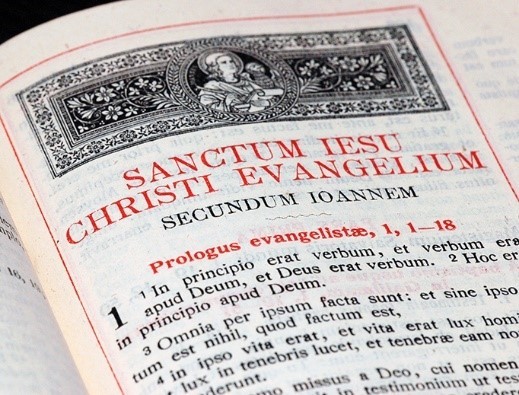
Vulgate was controversial due to it was the first translation that was not done using a literal translation, but by sense for sense. Additionally to that, “Vulgate relied heavily on the cross-reference of the original Hebrew text- which many Christian scholars at the time ironically believed “tainted” the religion with Judaism” (Faulwetter, 2018).
St. Jerome passed away on September 30, thus the celebration of the International Day of Translators takes place on that date.
Constance Garnett
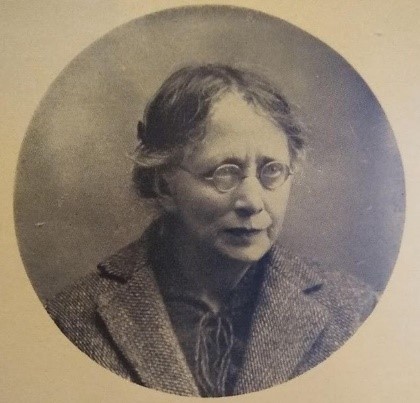
Constance Garnett was born on December 19, 1861, in Brighton, England. In a time when high-level education for women was rather uncommon, she won a scholarship to Newnham College, Cambridge, where she graduated and studied Latin and Greek. Constance married in 1889 to the critic Edward Garnett, who encouraged her to learn Russian.
Soon after, in 1892, she started her career as a translator by translating Russian works for publication by Leo Tolstoy and Ivan Goncharov. In one of her travels to Russia, she met Tolstoy, who asked her to translate his religious works, but Garnett refused as her main goal was to translate novels.
Constance was the translator who took the responsibility for translating the great works of Russian literature into English. She made works from Tolstoy, Goncharov, Gogol, Dostoyevsky, Ostrovsky, Herzen, Turgenev, and Chekhov available to English-speaking readers in the 20th century. She died on December 17, 1946.
Fun fact: “When Constance Garnett did not know the translation of a particular word or phrase, she would sometimes leave it out altogether” (Moser, 1988).
Natasha Randall explores the task of biographical research into the figure of the literary translator Constance Garnett. This talk attempts to figure out some details about the interior life of this magnificent translator, addressing questions, such as the following: Can her translations provide additional insight into her life and character? What are the detectable choices in Garnett’s work that can contribute to a portrait of her?
We can assure you that you will not regret watching this talk! Have a look at it by clicking on this link: https://www.youtube.com/watch?v=vbIZMzCVz8U
Jorge Luis Borges
Borges was one of the most proficient, successful, and famous Latin-American writers and poets. He has massively contributed to the field of translation, even though he never worked for an official translation agency.
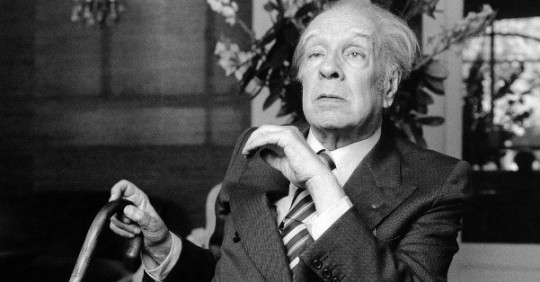
Since Borges was little, he was surrounded by foreign languages, at home he spoke English and Spanish, and, later, learned German and French. His reading was done mainly in foreign languages, focusing mainly on English texts.
“For Borges, Translation was not about transferring a text from one language to another, but rather to transform one text into another” (Mermoud, 2015). He stated that translation, even literal ones, changes their meaning due to the inherent changeability of texts according to the reader and to the place and time of reading.
This translator believed that high-quality translations could enrich or improve the source text since it provides, to any type of text, nuanced meaning, connotation, and association. According to Mermoud (2015), “Borges enjoyed leafing through different translations of the same text, often as a literary exercise, maintaining that any changes in linguistic code were encouraged in his opinion and at times necessary”.
Borges’ translation method/philosophy goes along with the belief that the work itself is “ultimately more important than its creator”. In that sense, Borges applied his own translation method which consisted of eliminating redundant or unnecessary elements in the source text, removing what he called “textual distractions” and adding nuance, or changing the tile, among other things. Borges is responsible for some of the best and most beautiful writings as well as translations.
Do you want to check one of his translations? Below you will find his translation into Spanish of a Whitman poem.
SONG OF MYSELF
I celebrate myself, and sing myself,
And what I assume you shall assume,
For every atom belonging to me as good
belongs to you.
Whitman
CANTO DE MÍ MISMO
Yo me celebro y yo me canto,
Y todo cuanto es mío también es tuyo,
Porque no hay un átomo de mi cuerpo
que no te pertenezca.
Translated by Jorge Luis Borges
Edward George Seidensticker
Edward Seidensticker was a translator, Japanologist, historian, author, and educator who was born on February 21, 1921, in Castle Rock, Colorado. His family had some financial struggles, which is why he attended the University of Colorado at Boulder and graduated with a degree in English in 1942.

His first approach to Japanese language and culture began during World War II, while he was accompanying the U.S. Marines ashore at Iwo Jima in his capacity as a language officer. Since then, his passion for the language has only increased.
Seidensticker traveled to Japan to work as a foreign service officer of the United States. Afterward, he decided to study Japanese literature at the University of Tokyo and focused on the modern side of literature. In the middle of the 1950s, he worked as a lecturer of both American and Japanese literature at Sophia University. “While there he became acquainted with some of Japan's most revered authors and began translating their masterpieces for American readers” (Fox, 2007).
During his lifetime, Seidensticker translated more than a hundred literary Japanese works, making able for English speakers to read authors, such as Yasunari Kawabata and Yukio Mishima, among others. He is considered one of the best Japanese literature translators due to his capacity to convey the same nuances and emotions that are portrayed in the source text.
In 1971, Edward won the National Book Award in the category of Translation for his version of Yasunari Kawabata’s “The Sound of the Mountain”.

His edition of “The Tale of Genji”, an 11th-century epic of love and intrigue written by Murasaki Shikibu, was praised by critics. This translation took Seidensticker more than ten years. Sadly, he died on August 26, 2007, in Tokyo, Japan.
Now you know some of the most important, famous, and proficient translators in history. There is a long list of people worth mentioning, so why not? Comment below other translators that we should talk about in the next post!
Salto de página
References:
Costa, W. C. (1996). Borges and Textual Quality in Translation. Cadernos de tradução, 1(1), 115-135.
Faulwetter, K. (2018, February 28). St. Jerome and the First Sense-for-Sense Method in Translation Studies. Motaword. https://www.motaword.com/blog/st-jerome#:%7E:text=Jerome%20coined%20the%20field%20phenomenon,than%20%E2%80%9Cword%20for%20word%E2%80%9D.
Fox, M. (2007, August 31). Edward G. Seidensticker - Obituary. The New York Times. https://www.nytimes.com/2007/08/31/arts/31seidensticker.html
Mermoud, M. (2020, September 9). Stories of translators: Jorge Luis Borges. Cultures Connection. https://culturesconnection.com/stories-of-translators-jorge-luis-borges/
Moser, C. (1988). Translation: The achievement of Constance Garnett. The American Scholar, 57(3), 431-438.
Nguyen, M. (2005). Prologue of the Gospel of St. John from the Clementine Vulgate [Photograph]. https://publisher-publish.s3.eu-central-1.amazonaws.com/pb-ncregister/swp/hv9hms/media/20200828040816_5f4868edc2bf74d8cce1d2ecjpeg.webp
Panetti, D. (1500). Saint Jérôme [Saint Jérôme]. Abbaye de Chaalis - Musée Jacquemart-André, Paris, France. https://upload.wikimedia.org/wikipedia/commons/thumb/3/38/Domenico_Panetti_-_St_J%C3%A9r%C3%B4me.jpg/467px-Domenico_Panetti_-_St_J%C3%A9r%C3%B4me.jpg
#dark acamedia#translation#language#linguistics#light academia#culture#writing#writerscorner#learning#literature#interesting
4 notes
·
View notes
Text
Happy Birthday 🎂 🥳 🎉 🎈 🎁 🎊 To You
1 Of The Most Distinguished & Legendary English Actress 🇬🇧👱♀️👵 Of Both Drama, Comedy & Kids / Family Movies 🎥 Of All Times
Thompson was born in London on 15 April 1959. Her mother is Scottish actress Phyllida Law, while her English father, Eric Thompson, was an actor best known as the writer–narrator of the popular children's television series The Magic Roundabout.
Born to actors Eric Thompson and Phyllida Law, Thompson was educated at Newnham College, Cambridge, where she became a member of the Footlights troupe, and appeared in the comedy sketch series Alfresco (1983–1984). In 1985, she starred in the West End revival of the musical Me and My Girl, which was a breakthrough in her career. In 1987, she came to prominence for her performances in two BBC series, Tutti Frutti and Fortunes of War, winning the BAFTA TV Award for Best Actress for her work on both series. In the early 1990s, she often collaborated with then-husband, actor and director Kenneth Branagh, in films such as Henry V (1989), Dead Again (1991), and Much Ado About Nothing (1993).
For her performance in the Merchant-Ivory period drama Howards End (1992), Thompson won the BAFTA Award and the Academy Award for Best Actress. In 1993, she received two Academy Award nominations—Best Actress and Best Supporting Actress—for the respective roles of the housekeeper of a grand household in The Remains of the Day and a lawyer in In the Name of the Father, becoming one of the few actors to achieve this feat. Thompson wrote and starred in Sense and Sensibility (1995), for which she won the Academy Award for Best Adapted Screenplay—making her the only person in history to win Oscars for both acting and writing—and once again won the BAFTA.
Further critical acclaim came for her roles in Primary Colors (1998), Love Actually (2003), Saving Mr. Banks (2013), Late Night (2019), and Good Luck to You, Leo Grande (2022).
PLEASE WISH THIS INCREDIBLELY & DELIGHTFULLY CHARMING ENGLISH ACTRESS & SCREENWRITER OF LONG LASTING ENTERTAINING CINEMA 🎥
A VERY HAPPY BIRTHDAY 🎂 🥳 🎉 🎈 🎁 🎊
YOU ALL SHOULD KNOW HER
YOU ALL HAVE GROWN UP TO TIMELESS & CLASSIC FILMS 🎥
& WE ALL ADORE HER ❤ EVERY TIME
THE 1 & ONLY
MS. DAME EMMA THOMPSON 🇬🇧👱♀️👵
HAPPY 65TH BIRTHDAY 🎂 🥳 🎉 🎈 🎁 🎊
TO YOU MS. THOMPSON 🇬🇧👱♀️👵 & HERE'S TO MANY MORE YEARS TO COME

#EmmaThompson #MuchAdoAboutNothing #SenseandSensiblity #Junior #LoveActually #HarryPotterSaga #NannyMcphee #SavingMrBanks #BeautyandTheBeast
#Emma Thompson#Much Ado About Nothing#Sense and Sensibility#Junior#Love Actually#Harry Potter Saga#Nanny McPhee#Saving Mr Banks#Beauty and The Beast#Spotify
1 note
·
View note
Text
dorothea "dorey" mason, twenty five, code-breaker // au: at the end of the world
dorey is not nearly as much of a stick in the mud as she might appear but she does have resting bitchface and a very serious job so sometimes. but there is a war on.
dorey is a dorothea and she was raised comfortably middle class in clapham by people who were on the fringes of bohemia but went straight after having their first child, jessamine. bloomsbury turned into clapham, writing jobs turned into teaching and keeping house and as the children kept coming, the names became less bohemian. jessamine (34) was followed by caspian (33), then dorothea and then finally, exhausted, jane (23).
dorey is very glad she's not jessa or cas. dorey is enough.
dorey came along once her father had become principal of a boy's school in clapham and the only remnants of their bohemian past were a certain liberality in the education of their children and encouraging them to do whatever made them happy. jessa was and is a talented artist, cas breeds horses in ireland, jane is studying to become a doctor, and dorey does math for both fun and a living.
she was always the studious one in her family and if her parents stopped being able to make heads or tails of her math homework before she hit puberty, they were still supportive. she won a scholarship to newnham college at cambridge and holds a double first in mathematics (but no degree because fun fact cambridge didn't give those to women until 1948. no she's not holding a grudge!).
by the time she finished, the war had started and as absolutely no war jobs held much appeal to her (weak ankles, too many years in a library), she was recruited to the government code and cypher school and eventually moving to bletchley park. there were a few frustrating weeks where she was primarily doing clerical work before being assigned to hut six as a codebreaker on army and air force engima deciphering.
(and if i have to dip any deeper, i am above both my pay grade and intelligence level)
dorey is very good at her work and take a lot of pride in it. she's always enjoyed puzzles and there's nothing like the rush of breaking a code. she's been called to the war office a few times and while she knows she's not going to get any kind of major recognition for her work, the pride is what keeps her working.
make no mistake, that does not mean she's accepted it. like the denial of a full degree, the lack of recognition chafes at her. as a result, she sometimes take herself too seriously. she presents herself well, never a hair out of place and always keeps her composure. it takes a lot to ruffle her. she's determined and stubborn and does not do a task unless she can do it with her full attention.
despite all of this, she is tender deep down. she's very close to her family and stays with jessa when she's in london (clapham's too far from the war office). she keeps a steady correspondence with cas in ireland and jane in america and while she worries that she's doomed to be the maiden aunt, she knows that they'll always love her. she can be sweet and thoughtful when she isn't in her head but until the war is over: she's got work to do and that comes first always.
1 note
·
View note
Text
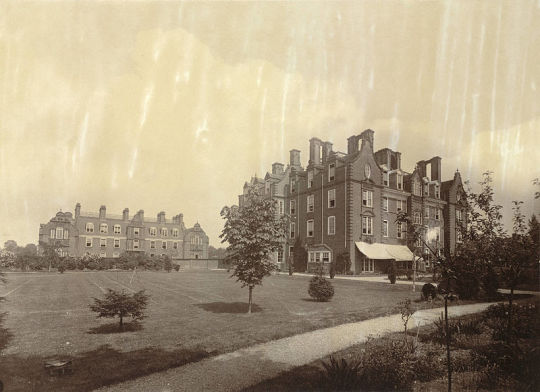
Week #3: Suffragist Anna Bateson, part of the story of the foundation of Newnham College, Cambridge.
📸Newnham College by A.D. White, made available by Cornell University Library
1 note
·
View note